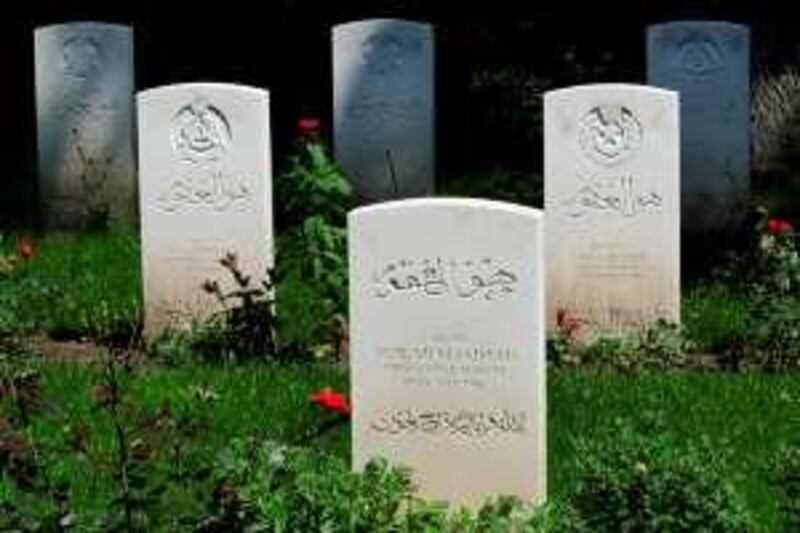Wünsdorf, Germany // South of Berlin, surrounded by woodland still contaminated with munitions, lies a small cemetery dedicated to Muslim, Sikh and Hindu soldiers that tells a bizarre and little known story of the First World War. Zehrensdorf cemetery, tended by the Commonwealth War Graves Commission, contains 206 graves of soldiers from India who had fought for Britain, were taken prisoner by the Germans and died in Half Moon Camp - a nearby POW camp set up in 1914 for 30,000 soldiers from the colonies of the Entente powers.
The deaths resulted from disease rather than any maltreatment. In fact, the Germans were at pains to treat their prisoners as well as possible. They built the first mosque on German soil in the camp in the garrison town of Wünsdorf, complete with a minaret and dome, and they respected Islamic, Hindu and Sikh religious practices, for example only issuing food rations after sunset during Ramadan, according to records of the time.
They also provided ample food and good toilet and washing facilities, as well as decent clothing. As war raged on Germany's western and eastern fronts, the military authorities even organised excursions into the surrounding countryside for their prisoners, and erected well-equipped workshops for them to fashion arts and crafts from their homeland. "This had little to do with altruism. It was part of a plan to turn the prisoners against their colonial masters and get them to fight alongside Germany," said Werner Leese, a former mayor of Wünsdorf.
The aim was to recruit soldiers to join the army of the Ottoman Empire, which was allied with Germany, and fight British forces in Egypt. Colonial troops made up a significant part of the Allied strength during the war, with nearly one million troops from undivided India fighting in the Middle East and Europe for the British, and 475,000 soldiers from French colonies in North and West Africa serving in the French army.
Two Indian infantry divisions, the Third Lahore and 7th Meerut, fought in Flanders and northern France at Ypres, Neuve-Chapelle and Loos and some of their units suffered almost 80 per cent casualties. Those taken prisoner and brought to Wünsdorf received visits from Turkish parliamentarians who tried to persuade them to wage jihad against Britain and France. However, the unprecedented propaganda campaign was not an unmitigated success. Only about 1,800 of the prisoners were dispatched to Turkey in 1916 to join the Turkish army, and historians estimate that around a quarter of POWs agreed to change sides.
"They had hoped that the prisoners would run over to the Germans in their thousands but that didn't happen," said Mr Leese. Wünsdorf officials have been telling the story of Half Moon Camp as part of a drive to attract tourists and investors by giving a taste of the town's fascinating history. "This place was a nerve centre of the two world wars as well as the Cold War," said Werner Borchert, head of the local tourist authority.
The town was chosen as the site of a military garrison and training area in 1908 and served as the command centre of the German army in the Second World War. The Soviets took it over in 1945 and turned it into their headquarters for the 546,000 Soviet troops stationed in communist East Germany. Most of Wünsdorf was a restricted military zone until 1994, when Soviet forces completed their withdrawal from eastern Germany in the wake of unification, and the place today has a deserted, forlorn feel.
Its population of just 6,000 - a 10th of the Soviet garrison that used to be billeted here - seems lost among the crumbling, four-storey barracks and tank repair workshops that line the streets in a confusing mix of German and Soviet military buildings, many of which are under monument protection. One officers' training college still has a proud statue of Lenin in front of it. Enormous concrete bunkers that housed Germany's army headquarters and were detonated by the Soviets after 1945 lie like felled monsters in the forest just metres from recently refurbished apartment blocks.
One bunker was converted by the Soviets into a supposedly nuclear strike-proof communications centre during the Cold War. Much of the area around Wünsdorf remains contaminated with a wide array of unexploded ordnance from almost a century of military manoeuvres and target practice. Wünsdorf has been trying to lure visitors by converting barracks into museums, art galleries, restaurants and book shops catering to military enthusiasts. Some of the buildings have been occupied by regional government departments for the state of Brandenburg.
The town is opening a museum on the Russian military presence in East Germany in September to mark the 15th anniversary of the Soviet withdrawal. Half Moon Camp's wooden mosque remained in use for a few years after the First World War and Muslims would come from Berlin to worship in it. But it fell into disrepair and was torn down in the late 1920s. Under Communism, the cemetery at Zehrensdorf fell into disrepair because it was located in a firing range and the Commonwealth War Graves Commission was denied access to it.
"It became totally overgrown and all the headstones went missing," Mr Leese said. "Local farmers used them as paving stones for paths." The cemetery was restored by the War Graves Commission and reopened in 2005. With its pristine, deep green lawn and neat rows of limestone headstones engraved in Urdu, Punjabi and Hindi, the place is an oasis amid the shell-infested wilderness around it. Muslims from the French and Russian armies are also commemorated. There is a memorial stone dedicated to Muslim Tatars who fought for the Russians and died in Half Moon Camp. And a monolithic red sandstone rock devoted to Muslims from North Africa who fought for the French stands facing Mecca.
@Email:dcrossland@thenational.ae






